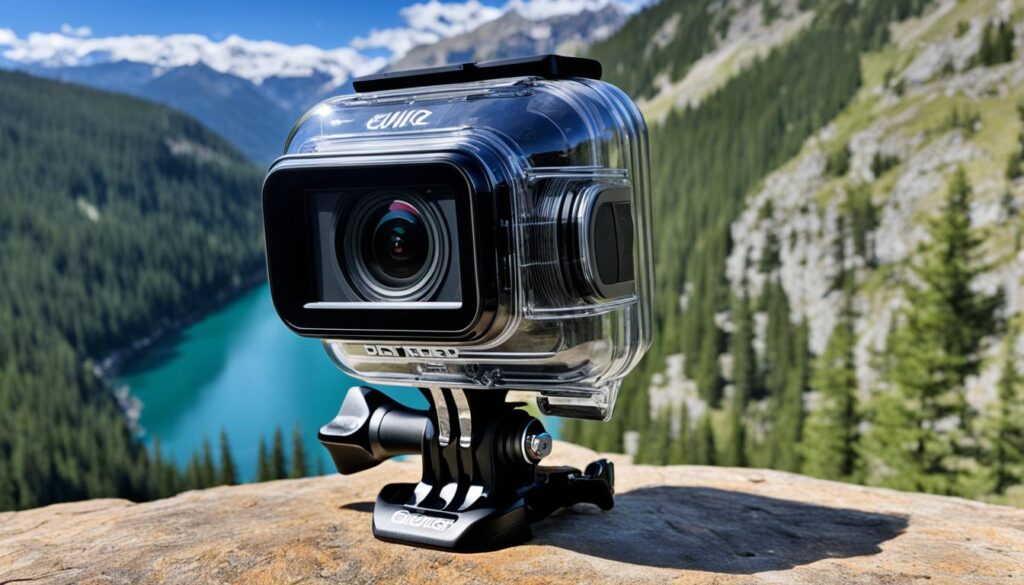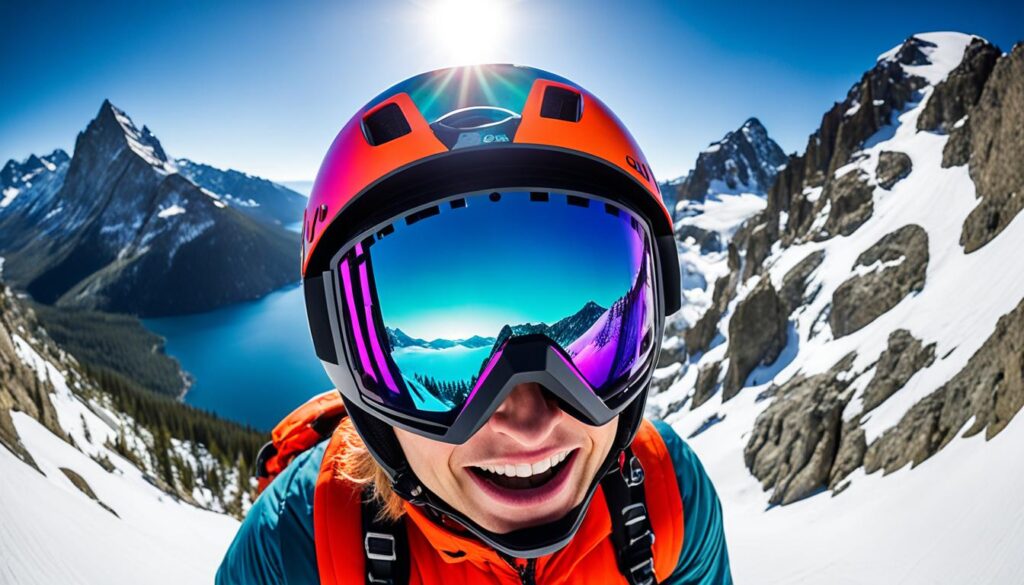
Are you an adventure enthusiast always on the lookout for the next thrilling experience? Whether you’re shredding down mountain trails, hitting the waves, or flying through the sky, capturing those exhilarating moments is crucial. But with so many helmet cameras on the market, how do you choose the best one that suits your needs?
When it comes to selecting a helmet camera, it’s essential to consider key features that will enhance your recording experience and ensure you capture high-quality footage. From mounting options to video quality and durability, making an informed decision is vital.
In this article, we will guide you through the essential features to look for in a helmet camera, helping you find the best one to document your adventures. So, before you embark on your next adrenaline-pumping journey, let’s dive in and explore the world of helmet cameras!
Key Takeaways:
- Consider various mounting options for capturing different perspectives and angles.
- Pay attention to video quality and resolution, aiming for at least 1080p Full HD or higher.
- Choose a helmet camera with a rugged and durable build for protection in extreme conditions.
- Look for helmet cameras with versatile mounting options and Wi-Fi connectivity for easy control and customization.
- Consider the battery life and storage capacity of the camera to ensure it meets your recording needs.
Mounting Options for Helmet Cameras
When it comes to capturing your thrilling adventures on a helmet camera, the mounting options play a crucial role in capturing the perfect angle and perspective. Whether you’re biking, skiing, or engaging in any high-energy outdoor activity, choosing the right mounting option can make all the difference. Let’s explore some of the popular mounting options and their benefits:
1. Helmet Mounts
The most popular and widely used mounting option is attaching the camera directly to your helmet. Using sticky mounts or goggle strap mounts, you can securely fasten the camera to the top, side, or front of your helmet. This position offers a clear view of the track ahead and provides a sense of body movement, immersing viewers in the action.
2. Chest Mounts
For a unique perspective that showcases the handlebars and the track ahead, chest mounts are an excellent choice. By strapping the camera to your chest using a harness, you can capture footage from a lower vantage point, giving a more immersive experience. This mounting option is particularly popular among bikers and motorcyclists.
3. Handlebar Mounts
If you want to capture videos that mimic your direction of travel, handlebar mounts are the way to go. These mounts allow you to attach the camera to your handlebars, providing a dynamic view of the trail or road. Bar clamp mounts ensure a secure fit, ensuring the camera stays in place even during bumpy rides.
4. Frame Mounts
For enthusiasts looking to capture unique perspectives and highlight suspension or drivetrain movements, frame mounts are a great choice. These mounts attach the camera to the bike frame, enabling you to showcase the intricacies of your ride. Frame mounts are especially popular among mountain bikers and motocross riders.
Each of these mounting options offers its own advantages, allowing you to capture different angles and perspectives that elevate the excitement of your videos. Experimenting with various mounting options can help you find the perfect setup for your specific outdoor activities.
Remember, the key to a thrilling video is finding the right mounting option that allows you to capture breathtaking footage while ensuring the safety and stability of your camera.
| Mounting Option | Advantages |
|---|---|
| Helmet Mounts | Provides a clear view of the track ahead and captures body movement. |
| Chest Mounts | Offers a unique perspective, showcasing handlebars and the track ahead. |
| Handlebar Mounts | Mimics the direction of travel, providing a dynamic view of the trail. |
| Frame Mounts | Captures unique perspectives, highlighting suspension and drivetrain movements. |
Video Quality and Resolution
One of the most crucial features of a helmet camera is its video quality and resolution. When capturing your adrenaline-fueled adventures, you want clear and sharp footage that truly brings your experiences to life. That’s why it’s essential to choose a helmet camera that offers impressive video quality and resolution.
For optimal viewing, look for a camera that provides at least 1080p Full HD resolution. This level of resolution ensures that your videos are detailed and vibrant, allowing you to relive every thrilling moment with crystal-clear clarity. However, if you crave even more visual impact and an unparalleled level of detail, consider a helmet camera that offers 4K Ultra HD resolution.

With 4K resolution, you’ll enjoy breathtakingly sharp and lifelike footage, capturing every intricate detail of your adventures. Whether you’re tearing down the mountain on your bike or soaring through the sky while skydiving, 4K Ultra HD resolution will elevate your footage to new heights.
It’s important to note that the resolution of a helmet camera directly impacts the clarity of the footage, especially when viewed on larger screens. Higher resolution videos retain more detail, immersing you in the action and allowing you to appreciate the small nuances that make your adventures extraordinary.
In addition to resolution, consider the frames per second (fps) value when selecting a helmet camera. Higher fps values, such as 60 or 120, provide smoother playback, particularly for fast-paced sports or action sequences. This ensures that every moment is captured fluidly, avoiding any choppiness that may detract from the overall viewing experience.
Durability and Waterproofing
When it comes to helmet cameras, durability and waterproofing are essential factors to consider. These cameras are exposed to extreme conditions, including impacts and exposure to water, during outdoor adventures. Therefore, choosing a camera with a rugged and durable build is crucial to ensure it can withstand the demands of your activities.
Look for helmet cameras that have been specifically designed to be impact-resistant and built to last. These models are engineered to withstand minor impacts without damaging the internal components, providing you with peace of mind during rough rides and challenging terrains.
To protect your camera in wet conditions, opt for a waterproof helmet camera. These cameras come with waterproof cases or have built-in waterproofing, allowing you to capture footage even in rainy or water-related activities such as surfing or kayaking. With a waterproof helmet camera, you can confidently document your adventures without worrying about water damage.
Benefits of a Waterproof Helmet Camera
- Weatherproof: With a waterproof camera, you can record in any weather condition, including rain, snow, or even underwater.
- Versatility: Waterproof helmet cameras are not only suitable for water sports; they also excel in other outdoor activities where the camera may come into contact with water, such as hiking, skiing, or mountain biking.
- Protection: The waterproof feature not only safeguards your camera against water damage but also protects it from dust, dirt, and other debris that you may encounter during your adventures.
- Reliability: A waterproof helmet camera ensures that you can focus on enjoying your activities without constantly worrying about the camera’s well-being, allowing you to fully immerse yourself in the experience.
| Feature | Benefits |
|---|---|
| Impact-resistant build | – Protects the camera from minor impacts – Ensures durability in rugged environments |
| Waterproofing | – Enables recording in wet conditions – Provides protection against water damage – Suitable for various water sports and other outdoor activities |
| Dust and debris protection | – Keeps the camera safe from dirt, dust, and debris encounters – Preserves performance and longevity |
“A waterproof helmet camera is a game-changer for outdoor enthusiasts. It allows you to capture your adventures without compromising the camera’s performance or worrying about water-related damage. Regardless of whether you are diving into the deep sea or biking through muddy trails, a waterproof helmet camera ensures you won’t miss a moment.” – Adventure Guru
Mounting and Versatility
The versatility of a helmet camera is crucial when it comes to capturing different angles and perspectives. To ensure you have the flexibility to capture your adventures from multiple viewpoints, consider cameras that offer:
- Multiple mounting options
- Compatibility with various mounts and accessories
Having multiple mounting options allows you to customize the placement of your helmet camera, ensuring you can capture footage from different positions. Whether you prefer mounting it on your helmet, chest, handlebars, or frame, the right camera will give you the freedom to experiment and find the optimal angle for your shots.

Additionally, look for helmet cameras that are compatible with a wide range of mounts and accessories. This opens up even more possibilities for creative mounting solutions, allowing you to attach your camera to various surfaces and objects. With the right accessories, you can capture unique perspectives and highlight specific aspects of your adventure.
In addition to mounting versatility, some helmet cameras offer Wi-Fi connectivity and smartphone apps, further enhancing their usability. With Wi-Fi connectivity, you can easily control your camera, remotely start and stop recording, and adjust settings from your smartphone. This eliminates the need to physically interact with the camera, ensuring you don’t miss any crucial moments. Wi-Fi connectivity also enables wireless previewing and transferring of footage, making it convenient to share your adventures with friends and family.
Pro Tip: Consider the battery life of the helmet camera when choosing a versatile model. Ensure that the camera can last through your intended duration of usage without needing frequent recharging.
Battery Life and Storage Capacity
When it comes to helmet cameras, battery life and storage capacity are crucial considerations for capturing your adventures without interruption. You want a camera that can keep up with your activities and provide ample recording time. Look for a helmet camera with a long battery life, ideally capable of recording for at least 2 hours on a single charge. This ensures that you have enough power to document your outdoor experiences.
Some helmet cameras go even further by offering extended battery life options. These cameras can be paired with external power banks, allowing you to record for longer durations without worrying about running out of battery mid-adventure. This feature is particularly beneficial for those participating in lengthy sports activities or engaging in all-day explorations.
In addition to battery life, considering the storage capacity of a helmet camera is essential. Some cameras come with built-in storage, while others require the use of memory cards. Check that the camera supports the specific type and capacity of memory card you plan to use. This ensures that you have enough space to store all your recorded footage without constantly worrying about running out of storage during your adventures.
Editing Software and Tips
When it comes to making the most of your helmet camera footage, having the right editing software is crucial. The right software can provide you with the tools you need to edit and enhance your videos, creating professional-looking results. Whether you’re a Mac or Windows user, there are several popular software options to choose from.
iMovie is an excellent choice for Mac users. It offers a user-friendly interface and a wide range of editing features. With iMovie, you can easily trim and merge clips, add transitions, and apply filters to enhance the visual appeal of your videos.
For Windows users, Movie Maker is a popular choice. Movie Maker allows you to edit your helmet camera footage with ease. You can add text, effects, and transitions, as well as adjust the color and brightness of your videos. Movie Maker also offers a straightforward interface, making it easy for beginners to create impressive edits.
If you’re using a GoPro helmet camera, you can take advantage of GoPro’s own editing software. It is available for both Mac and Windows users and is designed specifically for GoPro footage. With this software, you can easily import and edit your helmet camera videos, add music, and apply filters and effects to create professional-looking edits.
| Editing Software | Compatible Platforms | Key Features |
|---|---|---|
| iMovie | Mac | User-friendly interface, clip trimming, transitions, filters |
| Movie Maker | Windows | Text, effects, transitions, color adjustment |
| GoPro Editing Software | Mac and Windows | Designed for GoPro footage, music addition, filters, effects |
When editing your footage, there are a few tips to keep in mind. First, it’s important to keep your clips short and concise. This helps to keep viewers engaged and avoids overwhelming them with lengthy videos.
Additionally, consider adding appropriate music to your helmet camera footage. Music can enhance the mood and atmosphere of your videos, adding an extra dimension to the viewing experience. Be sure to choose music that matches the theme or style of your footage.
Finally, use transitions sparingly. While transitions can add polish to your edits, overusing them can make your videos appear amateurish. Instead, focus on smooth cuts between clips and let the footage speak for itself.
With the right editing software and these helpful tips, you can take your helmet camera footage to the next level. From trimming and merging clips to adding music and applying effects, you’ll have the tools you need to create impressive videos that showcase your adventures.
Conclusion
When it comes to choosing a helmet camera, there are several key features to consider in order to find the best option for your needs. First and foremost, think about the mounting options available. Whether you prefer to attach the camera to your helmet, chest, or handlebars, having the flexibility to capture different angles and perspectives is essential.
Next, pay attention to the video quality and resolution. Look for a camera that offers at least 1080p Full HD or even 4K Ultra HD for stunningly clear and detailed footage. Higher frames per second (fps) values will also ensure smoother playback, especially for fast-paced action sequences.
Durability and waterproofing are other important factors to consider. Make sure the helmet camera you choose can withstand the rigors of outdoor activities, including impacts and exposure to water. A rugged and impact-resistant build, along with waterproof features, will ensure that your camera stays protected no matter the conditions.
Lastly, consider the camera’s versatility, battery life, and storage capacity. Look for a camera that offers various mounting options, compatibility with accessories, and convenient features like Wi-Fi connectivity. Additionally, a long battery life and ample storage capacity will enable you to capture and store your adventure footage without any limitations.
By taking into account these key features, you can confidently choose the best helmet camera that suits your needs and budget. Enhance your adventure recordings and relive your exciting moments over and over with the perfect helmet camera by your side.
Source Links
- https://www.akasotech.com/blogs/what-are-the-key-features-to-look-for-in-the-best-budget-sports-action-camera
- https://www.bikeradar.com/advice/buyers-guides/what-to-look-for-in-a-helmet-camera
- https://techalogic.co.uk/what-to-consider-before-buying-a-helmet-camera/

Meet James Smith, affectionately known by friends as ‘Biker Smith’, your go-to expert at ‘Best HD Helmet Camera’. At 35, living in the USA, James embodies the spirit of adventure. His life is a thrilling ride, powered by his Harley Davidson Softail and BMW S 1000 RR, with his girlfriend as his favorite travel companion. A software developer by profession, James’s heart beats for the open road, making him a full-time traveler at heart. His passion for biking and technology merges seamlessly on this platform. Recognizing a gap in discussions around helmet cameras, he founded this blog to educate and inspire fellow enthusiasts. His mission? To elevate your riding experience with the best HD helmet camera insights, backed by firsthand experiences, rigorous testing, and a genuine love for the ride. Trust James to guide you through the world of helmet cameras, where quality, innovation, and safety ride together.